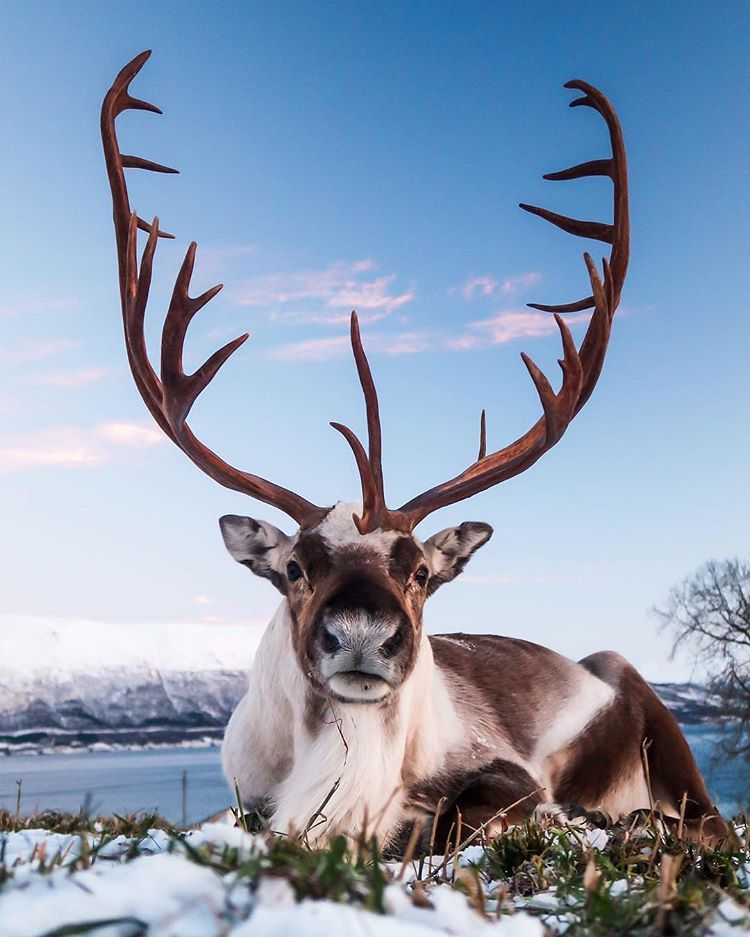Reindeer with big horns are among the most fascinating animals in the natural world, captivating researchers and wildlife enthusiasts alike. These magnificent creatures, also known as caribou in North America, boast impressive antlers that are not only a symbol of their strength but also play a crucial role in their survival and behavior. In this article, we will explore the life of reindeer, focusing on their physical characteristics, habitat, behavior, and the significance of their big horns.
As we delve deeper into the world of reindeer, we will uncover the various adaptations that allow them to thrive in some of the harshest climates on Earth. From their migratory patterns to their social structures, reindeer are a prime example of nature's ingenuity. Furthermore, we will discuss the cultural importance of reindeer in various societies, particularly among indigenous peoples of the Arctic regions.
Whether you are a wildlife enthusiast, a student of biology, or simply curious about these incredible animals, this comprehensive guide on reindeer with big horns will provide you with a wealth of information. So, let's embark on this journey into the world of reindeer and discover what makes them so special.
Table of Contents
- Biography of Reindeer
- Physical Characteristics
- Habitat and Distribution
- Behavior and Social Structure
- Diet and Feeding Habits
- Migration Patterns
- Cultural Significance
- Conservation Status
Biography of Reindeer
Reindeer (Rangifer tarandus) are a species of deer that belong to the Cervidae family. They are well-known for their unique adaptations to cold environments and their remarkable physical characteristics, particularly their large antlers. Both male and female reindeer grow antlers, which is unusual among deer species.
Personal Data and Biodata
| Scientific Name | Rangifer tarandus |
|---|---|
| Common Names | Reindeer, Caribou |
| Habitat | Tundra, boreal forests |
| Diet | Herbivore; mosses, lichens, grasses |
| Conservation Status | Least Concern (IUCN) |
Physical Characteristics
Reindeer are recognized for their distinctive physical traits, particularly their large, branched antlers. Here are some key features of reindeer:
- Size: Reindeer typically weigh between 90 to 300 pounds, with males being larger than females.
- Antlers: Males can have antlers that reach up to 4 feet in length, while females have smaller antlers.
- Fur: Their thick fur coat is essential for insulation against the cold, with hollow hairs that trap heat.
- Hooves: Reindeer have large, splayed hooves that help them walk on snow and soft ground.
Habitat and Distribution
Reindeer are primarily found in the Arctic and sub-Arctic regions, including parts of Alaska, Canada, Greenland, Norway, Sweden, and Russia. They inhabit tundra and boreal forest ecosystems, where they can find abundant food sources throughout the year. The following are notable aspects of their habitat:
- Tundra: This cold, treeless region is home to various lichens and mosses that reindeer feed on.
- Boreal Forests: These forests provide shelter and additional food sources during the winter months.
- Migratory Routes: Reindeer are known for their long migrations, traveling hundreds of miles between seasonal grazing grounds.
Behavior and Social Structure
Reindeer exhibit fascinating social behaviors and structures. They are known to form herds that can range from a few individuals to thousands during migration. Here are some key behavioral traits:
- Social Structure: Reindeer typically live in matriarchal groups, with females leading the herd.
- Communication: They communicate through various vocalizations, body language, and even scent marking.
- Breeding Behavior: Mating occurs in the fall, with males competing for the attention of females.
Diet and Feeding Habits
Reindeer are herbivores, primarily feeding on a range of vegetation that varies by season. Their diet consists of:
- Lichens: A primary food source, especially in winter.
- Mosses: Commonly consumed during colder months.
- Grasses and Shrubs: Available in the summer months when the snow melts.
Migration Patterns
One of the most remarkable aspects of reindeer is their migratory behavior. They undertake extensive migrations to access seasonal grazing grounds. Some key points include:
- Distance: Reindeer can migrate up to 3,000 kilometers (about 1,800 miles) each year.
- Seasonal Changes: Migrations are driven by changes in food availability and weather conditions.
- Navigation: Reindeer have an incredible ability to navigate using the Earth's magnetic field.
Cultural Significance
Reindeer hold a significant place in the culture and traditions of various indigenous peoples, particularly in the Arctic regions. Their contributions include:
- Food Source: Reindeer provide meat, milk, and other resources essential for survival.
- Transportation: Historically, reindeer have been used for pulling sleds and as a means of transportation.
- Spiritual Symbolism: Many indigenous cultures view reindeer as sacred animals, often featuring them in folklore and traditions.
Conservation Status
While reindeer are currently classified as "Least Concern" by the IUCN, they face various threats that could impact their populations. These threats include:
- Climate Change: Altered habitats and food availability due to changing temperatures.
- Human Activities: Habitat destruction, hunting, and industrial development.
- Predation: Increased predation from wolves and bears, particularly in areas where their populations are declining.
Conclusion
In summary, reindeer with big horns are remarkable creatures that play a vital role in their ecosystems and the cultures of the Arctic. From their impressive antlers to their migratory patterns, these animals showcase the beauty and complexity of nature. Understanding the challenges they face is essential for their conservation and for preserving the cultural heritage of the peoples who rely on them. We encourage you to leave a comment, share this article, or explore more related content on our site.
Penutup
Thank you for taking the time to learn about reindeer with big horns. We hope this article has provided you with valuable insights into these majestic animals. We invite you to return for more fascinating articles on wildlife and nature!


